Click the points on the map to learn more.

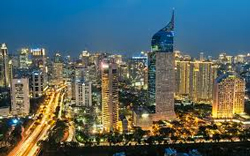 |
JakartaLocated on the island of Java, "Jaykarta" was the former capital of the Dutch East Indies. Although Dutch colonial rule came to an end in 1942, it wasn’t until 1950 that Jakarta officially became the capital of the new Republic of Indonesia and its name was restored. Today, Jakarta is the country’s administrative, commercial, industrial, and transportation center. It also serves as Indonesia’s largest port and is the center of the country’s export-import trade as well. Jakarta and it surrounding areas currently comprise the world's second most populous metropolitan area. |
| Back to Map | |
 |
BaliAlthough Bali is relatively small at 2,200 square miles, the island is densely populated and culturally and economically one of Indonesia’s most important islands. The Balinese people are skilled in farming and the arts (especially wood carving, music, dancing, and folk drama). They are Hindu in an overwhelmingly Muslim nation, and their culture is one of the reasons Bali is a top tourist destination of East Asia. The island also boasts unmatched scenic beauty, including beautiful beaches and active volcanoes. |
| Back to Map | |
 |
SumatraSumatra is Indonesia’s westernmost and second largest island. It’s home to the Bukit Barisan, a volcanic mountain range with more than 30 active volcanoes. Sumatra’s climate is hot and moist with heavy rainfall, giving the island swampland and impenetrable rainforests. The island has great natural wealth in the form of rich oil fields, coalfields, deposits of gold and silver, and plantations that grow most of Indonesia’s rubber, coffee, pepper, tea, and sugarcane. |
| Back to Map | |
 |
JavaJava is the fifth largest island of Indonesia, and makes up only one seventh of the country’s total area. However, it is also one of the most densely populated regions in the world, containing two thirds of the country’s population. Java was home to early humans. In 1891 fossilized remains of ‘Java man’ (Homo erectus) were found on the island. The remains of Java Man, once thought the missing link between apes and humans, are between 700,000 and one million years old. For centuries Java has been a political, economic and cultural center, containing most of Indonesia’s manufacturing centers, several universities, and widespread interest in literature and wayang, or shadow play, particularly in the cities of Yogyakarta and Surakarta. |
| Back to Map | |
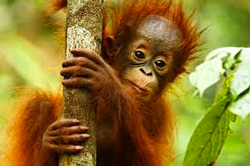 |
BorneoBorneo is the third largest island in the world. Indonesian Borneo (called Kalimantan by the Indonesians) covers 70% of the island, which is also shared with the Malaysian states of Sabah and Sarawak, and the sultanate of Brunei. The Dutch colonized the island in the early 1600s, with the British taking the north edge of the island in the 1840s. The final boundaries for the three countries occupying the island were defined in 1905. Dutch Borneo became part of the Republic of Indonesia in 1950, while Brunei became fully independent in 1984. The island these countries share is largely covered by dense jungle and mountains, much of which remains unexplored. Borneo is home to a diverse assortment of plants and animals, including the elephant, deer, orangutan, gibbon, Malay bear, and crocodile. |
| Back to Map | |
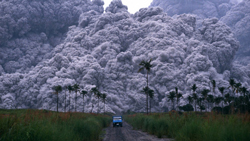 |
Toba VolcanoThe Toba Volcano is an important volcano studied by scientists because of its supervolcanic eruption said to have occurred about 75,000 years ago. The Toba supereruption was the largest known volcanic eruption during the past two million years. More than 600 cubic miles of magma were erupted, and all of South Asia and the surrounding oceans were covered in volcanic ash at least 6 inches thick. Today, the 62-mile long Lake Toba rests inside the caldera of the super volcano. |
| Back to Map | |
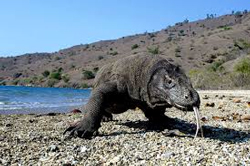 |
Komodo National ParkKomodo National Park is made up of three major volcanic islands and numerous smaller ones, in the center of the Indonesian archipelago. The islands’ dry climates and rugged hillsides contrast with the sandy beaches and coral-rich waters surrounding them. Komodo lizards are the most remarkable inhabitant of the park. Found nowhere else in the world, these giant lizards are often referred to as ‘Komodo Dragons,’ due to their aggressive behavior and average length of 6 to 10 feet. Because of the rich biodiversity within the park, Komodo National Park is a UNESCO World Heritage Site. |
| Back to Map | |
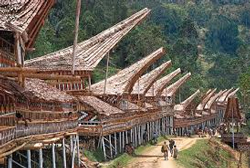 |
SulawesiFormerly known as Celebes, Sulawesi is the fourth largest island in Indonesia and the eleventh largest in the world. The island is home to over 18 million people. Sulawesi is famous for its archaeological sites including large, mysterious megaliths and cave paintings that are thought to be about 40,000 years old, making them the world's oldest paintings. |
| Back to Map | |
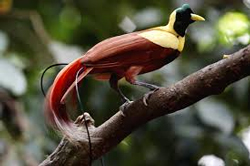 |
Papua ProvincePapua Province, formerly called Irian Jaya, is the easternmost and largest of Indonesia's provinces. It is home to incredible natural resources including the world's largest gold mine, vast rainforests, over 16,000 types of plants and numerous species of birds and reptiles. Papua is also home to the world's largest species of butterflies. |
| Back to Map | |
| Population: | 249.9 million |
| Area: | 735,000 square miles |
| Capital City: | Jakarta |
| Largest City: | Jakarta |
| Currency: | Indonesian Rupiah |
| Official Language: | Indonesian |
| GDP (Gross Domestic Product) | $868 billion |
- Indonesia is the largest archipelago in the world, containing over 17,000 islands
- 6,000 of Indonesia's 17,000 islands are inhabited by people
- Indonesia has the world's second largest tropical rainforest
- Over 740 different languages and dialects are spoken in the country
- Indonesia was settled by the Dutch in the 16th century; it gained independence from the Netherlands in 1945.
- Only China, India, and the United States have more people than Indonesia.
- Animals like the giant Komodo dragon and the Javan rhinoceros exist only in Indonesia
- Indonesia is spread over the Pacific “Ring of Fire,” and is home to over 400 active volcanoes
- Badminton is the most popular sport in Indonesia
- Indonesia is the world's most populous Muslim-majority nation. |
|
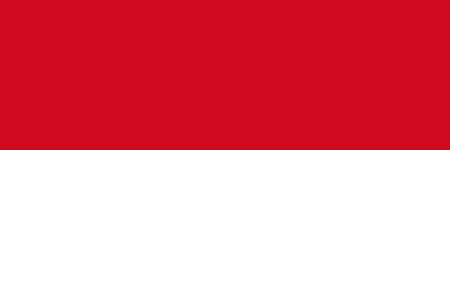 |
|
The red stripe represents courage, while the white represents purity. The colors come from the banner of the Majapahit Empire of the 13th-15th centuries. |
|